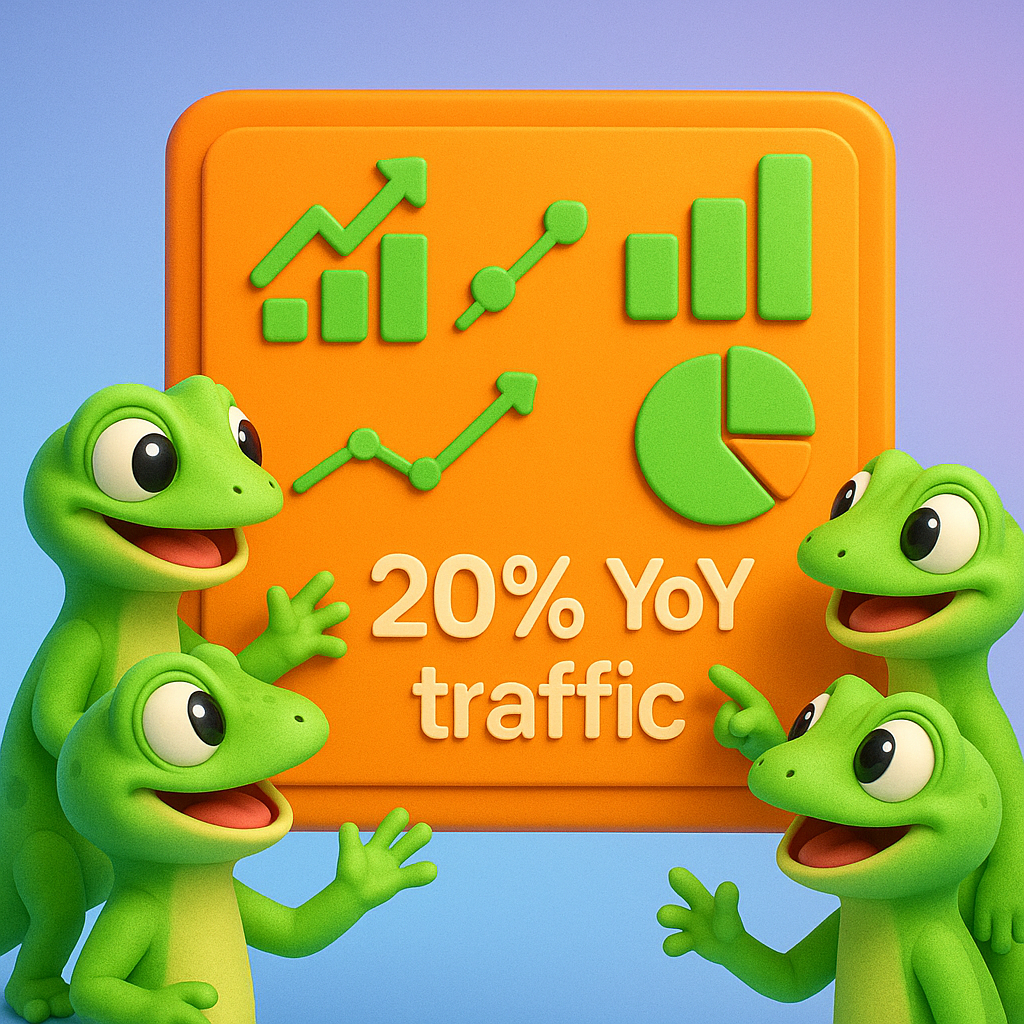Best practices for SEO performance reporting in 2024
Effective SEO performance reporting isn’t just about tracking rankings—it’s about connecting SEO efforts to business outcomes and providing actionable insights that drive strategy. For marketing leaders and SEO professionals, mastering this critical skill can be the difference between continued investment in SEO and budget cuts.
Essential components of effective SEO reports
Modern SEO reporting requires a strategic approach that balances technical metrics with business outcomes:
Reporting formats and frequency
- Executive summaries: Lead with clear KPIs (e.g., “20% YoY organic traffic growth”) that connect SEO to business impact
- Tiered reporting cadence:
- Weekly automated tracking for technical metrics (crawl efficiency, site speed)
- Monthly deep dives for strategic insights and recommendations
- Quarterly benchmarking against competitors and industry standards

According to recent studies, teams using unified reporting platforms saw 30-50% faster decision-making due to centralized insights, demonstrating the value of streamlined reporting processes. This efficiency allows marketing teams to pivot strategies more quickly when needed.

Critical metrics to include
-
Business-focused KPIs:
- Non-branded traffic growth (tied directly to new acquisition)
- Conversion metrics from organic channels
- Revenue attribution from SEO efforts
-
Performance metrics:
- Keyword rankings (especially for high-ROI terms)
- Organic visibility trends
- Click-through rates by position (with industry benchmarks showing 20-30% CTR for top 3 positions)
-
Technical health indicators:
- Site speed (aim for <2s load time)
- Mobile usability scores
- Indexation rates and crawl efficiency
Focus your reporting on the 20% of keywords that drive 80% of results—use an SEO ROI calculator to identify your highest-value targets and allocate resources accordingly.
Building a comprehensive SEO reporting system
Essential tools for data collection
A robust SEO reporting stack should include:
-
First-party data sources:
- Google Search Console (impressions, clicks, CTR)
- Google Analytics for SEO reporting (user behavior, conversions)
- CRM data for revenue attribution
-
Third-party platforms:
- Keyword tracking tools (e.g., SE Ranking, Ahrefs, Semrush)
- Technical site audit platforms for identifying technical SEO issues
- Competitor analysis solutions for benchmarking performance
-
Visualization and reporting:
- Data Studio dashboards for executive reporting
- Automated SEO reporting tools for consistent delivery
Integration strategies for comprehensive insights
The most valuable SEO reports integrate data from multiple sources:
-
Cross-platform data correlation: Connect ranking improvements to traffic and conversion changes. For example, show how a 5-position ranking improvement for a product page led to a 15% increase in conversions.
-
AI-powered analysis: Use predictive analytics to identify emerging trends and opportunities. This might include forecasting seasonal traffic patterns or detecting potential keyword cannibalization before it impacts performance.
-
Unified dashboards: Create single sources of truth that combine technical and business metrics. This allows stakeholders to see the full picture without toggling between multiple platforms.
Brands utilizing AI-integrated SEO workflows report saving 10+ hours weekly on reporting tasks, freeing marketing leaders to focus on strategy rather than data compilation. One case study revealed how a marketing team increased their content output from 5 to 50+ monthly pieces using AI workflows without adding additional staff.
Creating actionable SEO reports
The difference between good and great SEO reporting lies in turning data into action:
Stakeholder-specific customization
- C-suite executives: Focus on ROI, market share, and competitive positioning with high-level metrics like overall organic traffic share (ideally 40-60% for mature sites)
- Marketing teams: Provide keyword opportunities, content gaps, and performance trends at a tactical level
- Development teams: Highlight technical fixes with estimated traffic impact and priority rankings
Contextual framing techniques
- Historical comparisons: Show period-over-period changes (MoM, QoQ, YoY) to identify patterns and seasonal trends
- Industry benchmarking: Contextualize metrics against competitors and industry averages to set realistic expectations
- Predictive trends: Use AI to forecast future performance based on current trajectories, helping teams proactively adjust strategies
Visual storytelling best practices
- Use consistent color coding for metrics (e.g., green for improvements, red for declines)
- Implement clear labeling and annotations to explain anomalies
- Create hierarchy of information with most important metrics prominently displayed
According to marketing experts, reports framed as narratives (e.g., “Q2 traffic drop linked to algorithm update; recovery strategy implemented”) drive 40% better understanding among stakeholders. This storytelling approach transforms raw data into meaningful insights that prompt action.
Consider this example: Rather than simply reporting “CTR decreased 2% in May,” frame it as “May’s CTR decrease coincided with a competitor’s featured snippet capture; our content optimization plan targets regaining this position by July.”
Advanced SEO reporting considerations for 2024
AI overview adaptation
With the rise of AI overviews in search results, modern SEO reporting must account for:
- Tracking visibility in AI-generated responses
- Monitoring position zero/featured snippet performance
- Re-optimizing high-traffic pages for AI snapshots to mitigate traffic loss
Recent data suggests AI overviews may capture 44-75% of traffic for high-risk keywords, making this a critical addition to reporting frameworks. One tech tutorial site successfully re-optimized pages for AI overviews, significantly reducing predicted traffic losses after implementing strategic content restructuring.
Hybrid AI-human reporting workflows
Successful organizations are adopting hybrid approaches:
- Use AI tools like ContentGecko for data collection and preliminary analysis
- Leverage free keyword clustering tools to identify semantic relationships and topical relevance
- Apply human expertise for strategic interpretation and recommendations
- Implement content writing tools for efficient action on insights
Approximately 70% of leading businesses now blend automation with human expertise for SEO reporting oversight, creating more efficient and accurate systems. In one case study, proper keyword clustering boosted semantic relevance scores by 46% for a client, demonstrating the power of this hybrid approach.
Implementation roadmap
For organizations looking to enhance their SEO reporting:
-
Audit current reporting: Identify gaps between what you track and what drives decisions. Ask stakeholders which metrics actually influence their strategy.
-
Define KPI hierarchy: Establish primary, secondary, and diagnostic metrics based on business goals. For an e-commerce site, primary metrics might be organic revenue and ROAS, while secondary metrics include non-branded traffic growth and category page rankings.
-
Select appropriate tools: Choose solutions that match your organization’s size and needs. Enterprise organizations might need comprehensive platforms like Semrush or Ahrefs, while smaller teams can start with Google Search Console and targeted point solutions.
-
Implement automation: Reduce manual reporting time through scheduled reports and templated dashboards. Set up alerts for significant changes requiring immediate attention.
-
Establish feedback loops: Regularly review report usage and refine based on stakeholder input. The most effective reporting evolves based on actual utilization patterns.
TL;DR
Effective SEO performance reporting in 2024 requires balancing technical metrics with business outcomes, implementing a multi-level reporting cadence, and leveraging AI to streamline processes while maintaining human strategic oversight. Focus on actionable insights rather than data dumps, customize reports for different stakeholders, and ensure all metrics tie back to business impact. By implementing these best practices, marketing leaders can demonstrate SEO value more effectively and secure continued investment in organic search initiatives.
